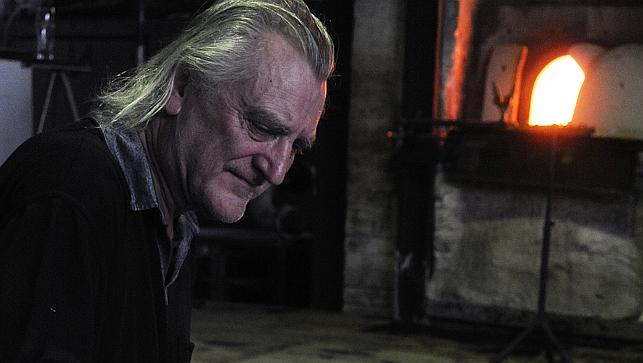Czech architect’s noteworthy collaboration
19.10.2012 / 00:36 | Aktualizováno: 19.10.2012 / 03:25
(This article expired 19.10.2015 / 00:36.)
Czech architect and glass sculptor Borek Šípek has always pushed the boundaries of his craft and so it is with his latest collaboration.
Sitting outside a small cafe on one of Prague’s cobblestone roads, Šípek sips his wine and carefully considers how to describe his newest venture – creating beautiful musical instruments solely from glass and replicating their original sounds.
He has collaborated with soloist Ondrej Smeykal to create a number of instruments, including (obscure as it sounds, sitting in the bustling Czech capital) a didgeridoo.

“The didgeridoo is not so difficult, you just have to keep it in proportion,” he says, waving his hands like a conductor. “The drums are more difficult, to get the nice tones in the glass. It’s about the thickness – you have to find both thick and thin sometimes.”
Šípek’s love of glass sculpture began decades ago, after the 1968 Russian invasion of then Czechoslovakia, while he lived in Germany studying architecture.
“I never intended to work with glass,” he says. “And then in 1982 [it] was the first time I could come back to Czech. I [had] just built a house in Hamburg and I contacted some friends and artists and I told them I would like to make a glass chandelier so they took me to their glass factory. It was fantastic, so I started to work with glass. It is a beautiful material.”
His romance with glass has spawned countless sculptures – from chairs, tables and candlesticks to vases and glasses. To say his creations are eye-catching is an understatement. While functional, they encourage a somewhat dreamlike form that would be better suited to a scene from Alice in Wonderland or Charlie and the Chocolate Factory. Indeed, on his website he says he “wanted all my things to be functional but not boring”.
“I didn’t want the user to get tired of them,” he says. “I wanted him to uncover their hidden qualities, gimmicks and pleasant surprises slowly and in a step-by-step fashion.”
The creative process can take years and it is never the same. “A table is easier than a chair. A chair is more complicated. I did a chair for the castle as part of my first order; it took two years. Sometimes it takes one day. Inspiration has to come,” he says while his gaze locks on his wineglass, analysing its seemingly simple structure.
“Inspiration is the most important. The hardest is when you are working on something and you feel the inspiration is not the right one so you have to get it out of your head. You have to fight against yourself.”
But despite his extensive catalogue of glass sculptures, which appear in nearly every chic or upmarket hotel or bar in Prague, Šípek admits his heart remains elsewhere.
“I enjoy architecture. I think this is my core and the design and others is easy . . . architecture is much more difficult and you have much more responsibility. A bad house remains for a long time. If you make a bad chair it is OK, you just put it away. The responsibility is nice.”
This responsibility is not just on exhibit in his Czech homeland. Šípek’s works can be seen in Tokyo, including at Komatsu department store; in the Netherlands, with the Apeldoorn apartments, and in Germany, at the car maker Skoda’s exhibition hall. His expertise has made him sought after among the Czech Republic’s aristocracy and its politicians. Šípek became close friends with the late first president, Vaclav Havel, and oversaw the restoration of Prague Castle. It’s a friendship he holds dear.
His piercing stare into the crowd turns blank as he remembers working on the castle but a smile returns to his face. “[Havel] was very interested in architecture because he comes from a builder family. He always told me what he thought I had to do and I always had to try to convince him I would do things completely differently. We fight a lot,” he says, chuckling.
But in typical Šípek fashion, he says he was unfazed working on one of the most highly recognised tourist destinations in Prague.
“There was no pressure. If you feel like there is pressure then you will make mistakes,” he says. “You have to be careful with the history. It was very difficult to work with the heritage.”
For his contribution to design and culture, Šípek was inducted into the French Order of Art and Literature in the 1990s, appointed professor of design at the University of Applied Arts in Vienna and has won numerous awards across Europe.
Considering his work in architecture and design, it is little wonder some projects remain a work in progress.
His original glass chandelier idea seems to fit into this category. “Chandelier is still not ready,” he laughs.
Source: The Australian Financial Review




